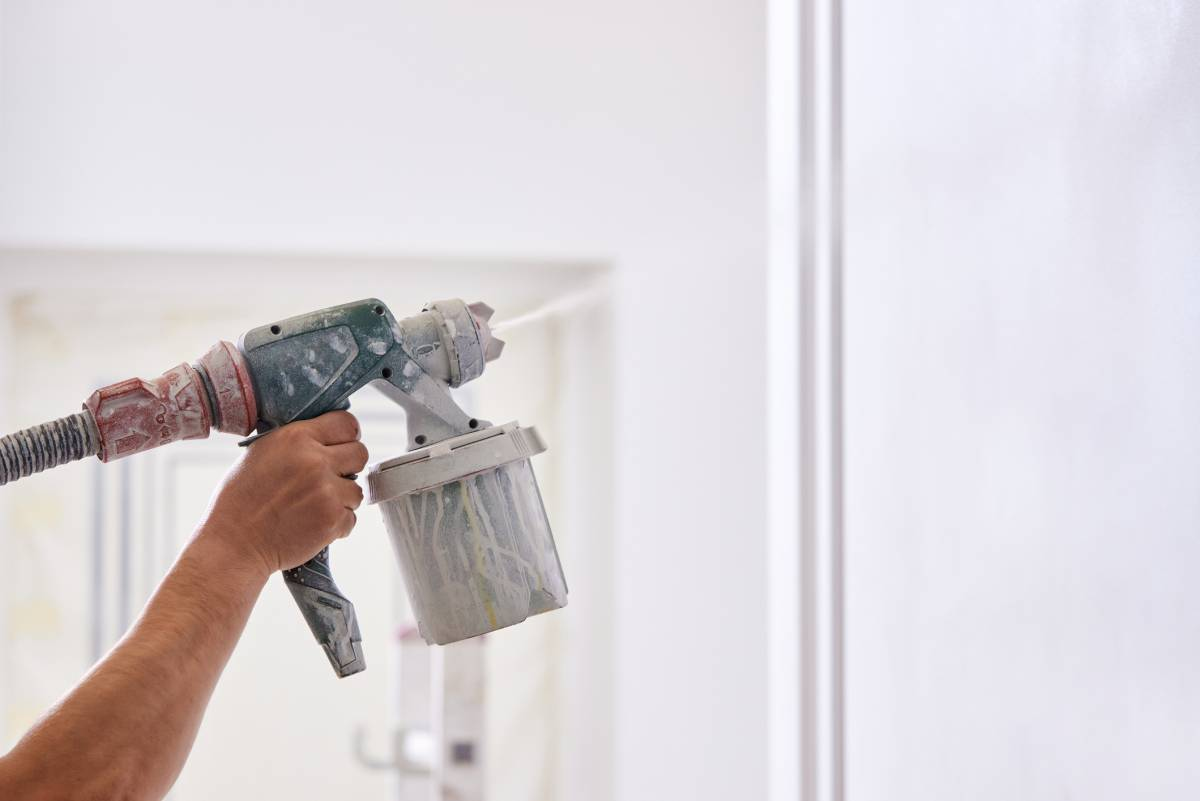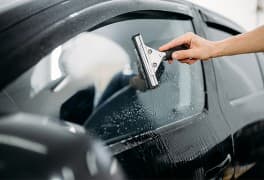
Find a local painter
- Inspiration /
- Indoor projects /
- Design & decor /
- Painting with a spray...
Painting with a spray gun vs paint roller
Spraying or rolling? Find out the best painting method for your needs.
Starting a redecoration can be overwhelming. Every decision counts, from deciding on wall colours and paint finish to whether to start painting with a spray gun vs a roller.
Choosing the right painting technique is important based on factors like whether the walls are textured or if you have prior interior painting experience. Even if you use the same paint colours, your paint application technique can influence its longevity.
In this guide, we’ll review the pros and cons of using a paint roller vs. spray gun for your next project. Read on to see how they stack up!
Painting with a spray gun

Advantages of using a spray gun
Spray guns are a popular choice for professional painters and advanced DIYers, thanks to their efficiency in covering large areas.
Wide coverage
Painting hard-to-reach areas like the ceiling is easier. You can cover large areas quickly versus going up and down with a roller frame. Using a brush or roller means you have to work in strips, “cut in” along corners and edges, while spray guns with precise jets let you easily cover all areas.
In addition, painting the house exterior is easier and much quicker with a paint sprayer, especially on large surfaces. You’ll want a perfect finish for larger jobs visible to more people (e.g., your house’s exterior).
Smoother paint finish
Spray painting your house creates an even finish on textured surfaces, corners, gaps, mouldings, cornices, and lap siding.
Disadvantages of using a spray gun
Spray guns might not be the perfect tool for every project or home painter. Before deciding to invest in a paint sprayer, it’s important to take note of these disadvantages.
Steep learning curve
Spray guns are not very beginner-friendly. If you have yet to gain experience with painting, specifically using a paint sprayer, getting the painting right will require a lot of trial and error. It might be best to leave spraying paint to your local house painters.
Extensive prep work, maintenance, and cleanup
Since paint guns cover everything in a fine mist of paint, you’ll need to mask and cover everything you don’t want to be sprayed. Afterwards, you’ll have to clean the equipment’s hoses, nozzles, and pumps. This includes using all the paint you loaded in the same sitting since any excess can clog up the sprayer.
Increased project cost
Paint sprayers are more expensive than rollers and brushes. They also use more paint, which can up your total painting project cost.
Best practices for using a paint sprayer
If you choose a paint sprayer, making your new investment count is important. Here are some tips to help you with your first painting project:
- Remember that the greater the spray coverage, the thinner each layer of paint is. You might need to go back and forth to get a good coat on your walls or ceiling.
- Practice beforehand. Get some scrap wood and practice aiming the paint sprayer nozzle at precise areas.
- Before painting interior walls, clean the surfaces to help the paint adhere better.
Painting with a paint roller

Advantages of using a paint roller
Paint rollers are a classic home painting tool that can be used for any painting project. Continue scrolling to find out why.
Ease of use and versatility
A paint roller is best for most house painting projects because it’s easier to use and get the hang of. You can even pair the roller with an extension pole to reach the higher areas on your interior walls or ceilings. Plus, they’re quite forgiving even if your walls aren’t perfectly clean.
Minimal cleanup or maintenance
Get the appropriate paint thinners, and you’re good to go! There is no need to set up or set down lots of equipment.
Cost-efficiency
Paint rollers, covers, and trays are relatively inexpensive. Plus, they maximise the paint with each roll.
Disadvantages of using a paint roller
Paint rollers, while known for their ease of use, are not the most efficient for some applications. Here are some of the limitations of this painting tool:
Not suitable for textured or intricate surfaces
It’s hard to achieve even finishes on textured surfaces when using paint rollers. Popcorn ceilings, intricate crown moulding, and other designs are hard to cover with a roller brush. Also, gaps and corners might not be painted as evenly. This is where a regular paintbrush could help.
More time-consuming
It takes up more time than using a paint sprayer. Since you’ll be applying paint in sections as wide as your roller, it will definitely be more time-consuming.
Best practices for using a paint roller
While using a paint roller seems like a no-brainer, there are some best practices you can try to improve your painting experience:
- Have two rollers ready: a 20-inch roller for large surfaces and a 10-inch one for corners.
- Make sure you choose high-quality roller covers. Cheap roller covers will shed or leave lint on your walls while rolling paint, messing up an otherwise smooth surface.
Painting with a spray gun vs paint roller: Which is more ideal?

In terms of surface type or area
Paint sprayers work best for exterior painting or empty houses that don’t require much prep work (e.g. masking and drop cloths). They’re also ideal for large areas and textured surfaces, such as popcorn ceilings, mouldings, and ornate walls.
Meanwhile, paint rollers are great for interior and furnished areas since it takes less effort. If you’re painting a smaller, non-textured area, paint rolling is the way to go.
| Recommendation: If you’re painting a new, empty room with rough textures, go for spray painting. For redecorating, you can keep it simple with a paint roller. |
In terms of preparation and setup
Whether you’re using a spray gun or roller brush, you’ll want to prep your area via masking or drop cloths as well as clean the surfaces. Wear protective equipment such as gloves, a mask, and goggles.
If you’re using a paint roller, here’s an overview of what to prep before you start:
- First, de-fuzz your high-quality roller covers, wash them, and then fit them onto the frames.
- Pour paint into the paint tray reservoir, being careful not to overfill.
- Dip the roller into the paint, covering less than half of it. Roll it on the ramp of the tray to distribute the paint.
- Pick a section of the surface to start on. Apply paint in a zigzag pattern. Then, fill the gaps in criss-cross strokes. Do a second coat using long, parallel strokes.
- Go over the paint with gentle strokes to “lay off” or redistribute the paint and avoid visible brush strokes.
If you’re using a spray gun, here are the steps to setting up and using one:
- Prep your paint and paint sprayer. First, thin down the paint to the consistency of milk. Then, set the fan to an appropriate size for the area you want to cover.
- Use a paint strainer to pour the paint into the gun, filling it up only up to 3/4 of the way. Secure the lid.
- Turn the compressor on and attach a coupler to the spray gun. Set the compressor to the proper pounds per square inch of pressure (PSI) based on the manual’s recommendation.
- Next, test the spray gun on scrap wood, cardboard, or paper. Adjust your air, fluid, or fan and practice your aim.
- When you’re ready to paint, hold the gun 10-16 cm away from the surface and face it perpendicularly. Don’t paint at an angle–this could cause uneven coverage.
- Paint walls from the top of the surface and work from left to right, in rows going downward, making sure to overlap your rows. For the second coat of paint, spray in columns to ensure even coverage.
| Recommendation: It depends on whether you can afford more prep or painting time. The preparation time for a spray gun might be the same as the time spent painting and laying off using a roller. And this doesn’t even include the extensive masking spray-painting required. |
In terms of paint consumption and efficiency
Earlier, we mentioned that paint sprayers are great at evenly distributing paint in a short time. But some paint might be wasted since you’re aiming thousands of little paint drops at a surface. Paint rollers, on the other hand, allow for more control and efficient use of paint.
| Recommendation: If you want to save paint, use a roller. If you want to save time, use a paint sprayer. |

In terms of versatility for various paint types
Most paint types, from water-based to oil-based, primers to rust-preventive, can be used for spray guns. Just make sure to thin them before application.
Meanwhile, with paint rollers, you’ll only need to pick the appropriate roller cover for your paint type. Oil-based paints require wool or mohair covers, water-based paints need synthetic covers, and latex paints apply best using foam or microfiber rollers.
| Recommendation: Both a spray gun and a paint roller can be used for various paint types since they’re versatile for different interior paint jobs. |
In terms of control and precision
When it comes to painting with a spray gun vs roller, each has its own advantages for control and precision when painting surfaces. Spray guns make it easier to cover textured areas efficiently. But they’re not the most beginner-friendly tool. So, a paint roller combined with some brushes could be a good option for control and precision.
| Recommendation: Use a paint roller if you need to paint more precisely. The learning curve for achieving precision is easier with a paint roller. Painting methods and the painting process will vary depending on the tool used and the surfaces that need painting. |
In terms of skill and experience required
Paint rollers are easier to use and maintain and more forgiving during application. Conversely, spray guns can be trickier to use. Not to mention, since they cost a bit, you’ll need to invest in the equipment, and the time it takes to learn how to use it.
| Recommendation: Paint rollers are easier to learn to set up, use, and maintain. But if you feel that spray guns are more useful for your projects and you have the extra time and paint to practice, there’s no reason you shouldn’t try using a paint gun. |
Is it better to DIY or hire a professional painter?
Being a DIYer for your upcoming repainting job can be fun and fulfilling! But it can also be taxing: there’s a learning curve in choosing paint, getting the roller method down pat or setting up your paint sprayer, and you’ll need to do everything from setting up to cleaning up.
Here are some tips to make DIY painting easier:
- Do your research. Learn about the different types of paint, techniques for preparing surfaces and cleaning up, and even other supplies to consider, such as thinners, primers, and top coats. The more you know about painting, the better prepared you are before you buy a single can of paint.
- Have buffers for extra materials (e.g. to practice your spray gun) and extra time (when you get tired)
- See if you can ask other people for help. One tip to get the best of both spray guns and brush painting is to do ‘back brushing’, where you spray first, then have a partner brush the paint to distribute it evenly in the area.
Of course, it’s also good to consult professional painters who can recommend painting tools and discuss painting techniques if you decide to go the DIY route.
It may be worth considering calling a pro to do the painting job to ensure a seamless paint application. Complex projects that involve old walls, decorative ceilings, stripping old layers of paint, or working with specialty paints will benefit from the expert touch of a pro.
Even if you do like to DIY, you can save yourself some time and energy by hiring a house painter. They already know the painting techniques, tips, and strategies to give your home the paint job it deserves.
Get help from painting professionals with Oneflare
By now, you’re armed with knowledge on how to tackle your paint job. Whether you want a paint sprayer that eliminates the need for manually brushing nooks and crannies or want to use an old-fashioned paint roller, you’re ready to decide on what to get at the paint supply shop!
If you want a deep dive into all things painting, such as the best paint rollers or paint sprayers, common interior painting problems, or even ask the pro painters to do the work.
FAQs on painting with a spray gun or paint roller
Is it better to paint with a spray gun or a roller?
It depends on what you’re painting and what your goal is. A paint sprayer eliminates the need for manually brushing or rolling over textured surfaces. It also helps you get even finishes faster.
But, it is also more expensive due to the equipment, the amount of paint needed, and the preparation required. Meanwhile, rollers are easier to use but may be more time-consuming.
Do professional painters use spray guns?
Yes, some professional painters use paint guns and airless paint sprayers to get work done more efficiently.
Is a paint sprayer easier than a roller?
No. In fact, a paint sprayer has a higher learning curve than a paint roller. But it makes painting easier and more efficient once you get the hang of it.
How long does spray painting a house last?
It typically lasts five or more years, depending on the quality of the paint job and aftercare.
How much will your job cost?
The Oneflare Cost Guide Centre is your one-stop shop to help you set your budget; from smaller tasks to larger projects.



